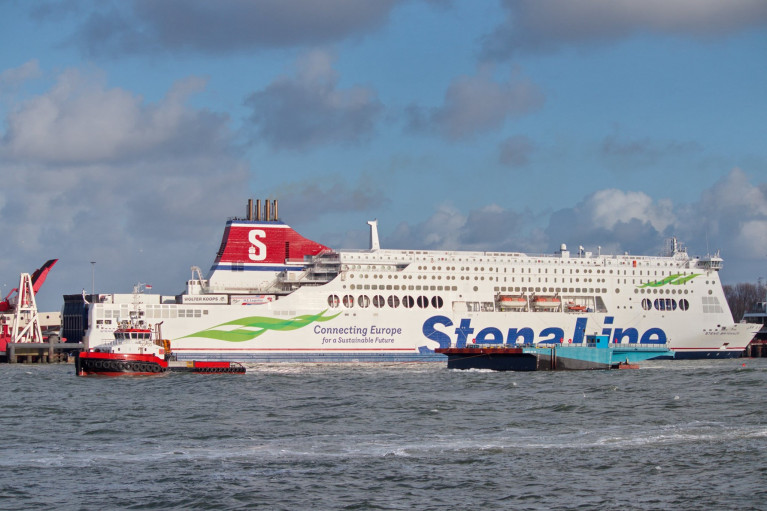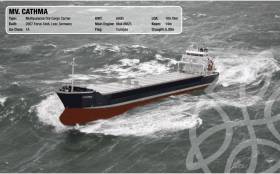Displaying items by tag: ABR Project
Dublin Port welcomed the arrival of new port infrastructure in the form of a linkspan which was transported by a supporting barge structure from the Netherlands last month, writes Jehan Ashmore.
The new linkspan (No. 7) will form part of the Alexandra Basin Redevelopment Project (ABR) at Dublin Port. The ABR where works are ongoing, represents the first major phase in the capital development project of the port's Masterplan 2040.
DPC awarded a contract for its constuction to Ravestein BV. The inland yard based in Deest is from where the linkspan was towed intially upriver (Waal) to the Port of Rotterdam.
In the second stage of the linkspan's delivery voyage, this involved the tug Noordstroom take over towing operations at Europe's largest port. Before the project cargo reached the open sea, the linkspan passed the Hoek van Holland (see photo above). The ferryport which is located close to the North Sea is also on the banks of the New Waterway (Nieuwe Waterweg) which connects to the Port of Rotterdam.
Also seen above at the Hoek van Holland is the Stena Britannica (at 64, 039grt, is ranked the world's 4th largest ferry). The giant ferry was berthed at a linkspan of the Dutch port which connects Harwich in UK as Afloat previously reported in the run up to Brexit.
A linkspan is a structure used to facilitate ro-ro traffic movement from a berthed vessel (via the bow or stern door ramps) to embark or dismembark vehicles ashore.
In the case of linkspan No. 7, Dublin Port plan to position the structure at the new Cross Berth Quay (Berth 26) as a bankseat within the ABR. Vessels that will use this new linkspan (ro-ro jetty which was shortlisted for an engineering award) will berth on to the south side of this new facility located in the centre of the basin.
Cargoship Calls to Capital to Load Concentrates for Dublin Based Group
#Concentrates – It is pleasing to concentrate on an Irish based ship management company that otherwise is not widely documented in mainstream media, writes Jehan Ashmore.
Cathma, a multipurpose dry-cargo carrier with an Ice Class (1A) certification was tracked by Afloat to the vessel's berth in Dublin Port this morning. The 100m long cargoship is managed by Corrib Shipping Group. The Dundrum based group also comprises a number of shipowning companies.
The 6000dwt Cathma as previously reported on Afloat’s ‘Cargoship’ focus discharged fertiliser in Foynes last year, belongs to the Group that was established in 1995. As part of the management team role, they are tasked to employ professional officers and crew to man its vessels.
Cathma is flagged in Curacao, a Dutch island in the Caribbean, is docked in Alexandra Basin along the north side of the 230m Bulk loading jetty. The facility completed in 1967 is served by rail-wagons laden with lead and ore concentrates from Bolidan Tara Mines in Co. Meath.
The loading facility in Dublin Port, which this year is 50 years old, is to be demolished as part of the port’s Masterplan. This involves phase one of a major €230m Alexandra Basin Redevelopment (ABR) project where quayside reconfiguration is underway to accommodate much larger deep drafted ships.
A new bulk-mineral loading facility will be reinstated within the basin.
Corrib Shipping also sail their ships as part of Royal Wagenborg (a Dutch operator of more than 170 ships) that acts as chartering agents for the Irish based group.
In January, Afloat investigated into the details of the 118m Viechtdiep, a 7,200dwt cargoship that was acquired by Corrib to become the group's fifth ship. The vessel was drydocked to emerge as the Dutch flagged Ziltborg operating for Wagenborg.
World's Largest Ro-Ro Ferry to Be Introduced on Dublin Routes Linking Mainland Europe
#worldlargest - The world's largest ro-ro ferry described as a 'game-changer' is to make a maiden call this week to Dublin Port from Zeebrugge and is to be followed with an introduction on the Rotterdam route, writes Jehan Ashmore.
Landlocked based shipping operator, CLdN ro ro S.A. with headquarters in Luxembourg, is to launch the giant 234m ro-ro freight ferry M.V. Celine with a capacity of 8,000 lane meters on the Ireland-Belgium route. The longer Dutch link will also be served by the giant ship. Beforehand of CLnd/Cobelfret's Dublin operations they had served out of Rosslare Europort until transferring to the capital in 2010.
Such sized ships will play an even bigger role given the reality of a 'post-Brexit' EU when the need to have direct sea-transport links with added capacity between Ireland and continental mainland Europe will become increasingly apparent.
Celine is to dock at Dublin's Ocean Pier in Alexandra Basin East which adjoins the larger basin of the same name from where the single largest redevelopment project in the past 200 years of the port is underway. Also related to the ABR project is the Capital Dredging Programme that began at the weekend with works in the basin along with those in the bay due to be completed by March 2018.
Newcomer Celine draws a maximum depth of 8.1m and this demonstates the requirement for Dublin Port to maintain that the channel approaches meet the demands from this ship and ever increasing larger and deeper draft ships to safely navigate and be accommodated within the port.
One of CLdN Ro Ro ships serving with sister company Cobelfret Ferries on the route linking Zeebrugge, Mazarine, namesake of her class which having reported for Ships Monthly in 2010 (Feb issue) made today a lunchtime arrival to Dublin Port. This 196m ro-ro can carry just 180 trailers, whereas the newbuild will take considerably more with 580. Such trailer traffic will involve a purpose-built ramp linkspan currently under construction in Alexandra Basin in which Afloat will have further to report.
Asides standard unaccompanied trailers, Celine's capacity caters for tank containers, project cargo, new cars and a capacity for 12 driver accompanied units. The leadship newbuild completed by Hyundai Mipo in Ulsan,South Korea represents a fleet expansion plan for CLdN, with a sistership due in the coming months.
Currently the largest ro-ro vessel using Dublin Port is Stena Line's passenger/vehicle ferry, Stena Adventurer which has a length just shy of 211m. By coincidence the Holyhead serving ship introduced in 2003, was also built by the same Asian shipyard.
As previously reported on Afloat back in early 2016, CLdN also operates an extensive northern European network, had then confirmed two more vessels ordered but through Croatian shipbuilder Uljanik along with an option for a further four ships but with a smaller 5,400 lane metre capacity.
Dredging in Dublin Port Begins With Material Dumped in Dublin Bay
#dredging- Dredging works in Dublin Port that began yesterday are to continue to March 2018 which will involve moving loaded material out to sea and dumped in Dublin Bay, writes Jehan Ashmore.
The works are part of the Capital Dredging Programme 2017 that arise from the Alexandra Basin Redevelopment (ABR) Project which is phase one of the Port's Masterplan 2012-2040 (see first review). The dredging will permit much larger and deeper draft cargoships and cruiseships to enter the port.
Last month concerns were raised by campaigners about the safety of the Dublin Bay porpoise as Dublin Port also undertook routine maintenace dredging that involved dumping material on a site off the Baily Lighthouse, Howth Peninsula. At the time the Journal.ie wrote that the Protect Dublin Bay group said that the area should be protected from waste.
Afloat noted the Belgium flagged Minerva, a trailer suction dredger began carrying out operations yesterday in Dublin Bay, a day later than envisaged.
The 2016 built green hulled dredger operated by New Waves Solutions, a subsidiary of the Dredging, Environmental & Marine Engineering DEME, was working consistently off the Dublin Bay bouy, located in the centre of the bay.
Dublin Port Company was granted a license Foreshore Consent by the Department of Housing, Planning Community & Local Government and a Dumping at Sea Permit from the Environmental Protection Agency (EPA).. The dumping of dredged material for this particular programme is described in an area as Outer Dublin Bay which is subject to conditions.
Under the terms of the EPA's Dumping at Sea Under permit, a maximum of 8,760,000 tonnes of dredged material may be loaded and dumped at sea up until and including 31 March 2021.
For much much information on the dredging works including documents on the Dumping at Sea permit (S0024-01) and A Notice to Mariners click here.
In addition if you have any concerns Dublin Port Company have issued contact details with respect to the Capital Dredging Programme. They can be contacted during normal business hours by asking for Charlie Murphy or Eamon McElroy by calling 01 887 6000 ; or by post to Dublin Port Centre, Alexandra Road, Dublin 1; or email: [email protected]
Alternatively concerns can be raised by contacting the Office of Environmental Enforcement Agency, EPA see website and for contact information from this link.
#ABRnotices - As part Dublin Port's Alexandra Basin Regeneration ABR Project, the existing Lead in Jetty located outside Graving Dock Number 2 that closed in February, is to be demolished.
Afloat adds tallship Jeanie Johnston made history as the last dry-docked vessel that also used the jetty following the closure of the unique facility in the capital.
It is expected that the works of Notice to Mariners No. 19 at the Jetty will take place from the 20th March 2017 to the 31st October 2017. (Circa 7 months’ duration)
The works consist generally of the demolition of an existing Lead in Jetty located at the entrance to the existing Graving Dock No. 2. It is required to demolish the existing lead in Jetty in order to provide access to future Berths No. 27 and No. 28 to the North West corner of the Alexandra Basin.
The Lead in Jetty is 120m long x 10m wide x 10m deep and is constructed of concrete caissons filled with gravel.
The following Vessels will be utilized for the demolition works to the Lead in Jetty:
1. 14 CD Spud Leg Dredger “Aoibheann”.
2. 25 TBP Single Screw Tugboat “M.T. Gargal”
3. Work Pontoon “Sandfisher”.
All craft will monitor Channel 12 continuously and show the required lights and shapes. All vessels should pass at slow speed and make due allowance for this operation.
VTS will keep all vessels updated and advised of any relevant information.
Further information on the ABR project can be found by clicking on the following link: http://dublinportabr.ie/
All Notice to Mariners among them further related ABR project developments are outlined below with links to open and download in PDF format.
No. 20 of 2017 New Quay Wall Works - Alexandra Quay West/Ocean Pier, Berths 31/32 click here
No. 21 of 2017 New Quay Wall Works - Alexandra Quay West, Berth 28 click here
For other Notice to Mariners they can be consulted here

























































